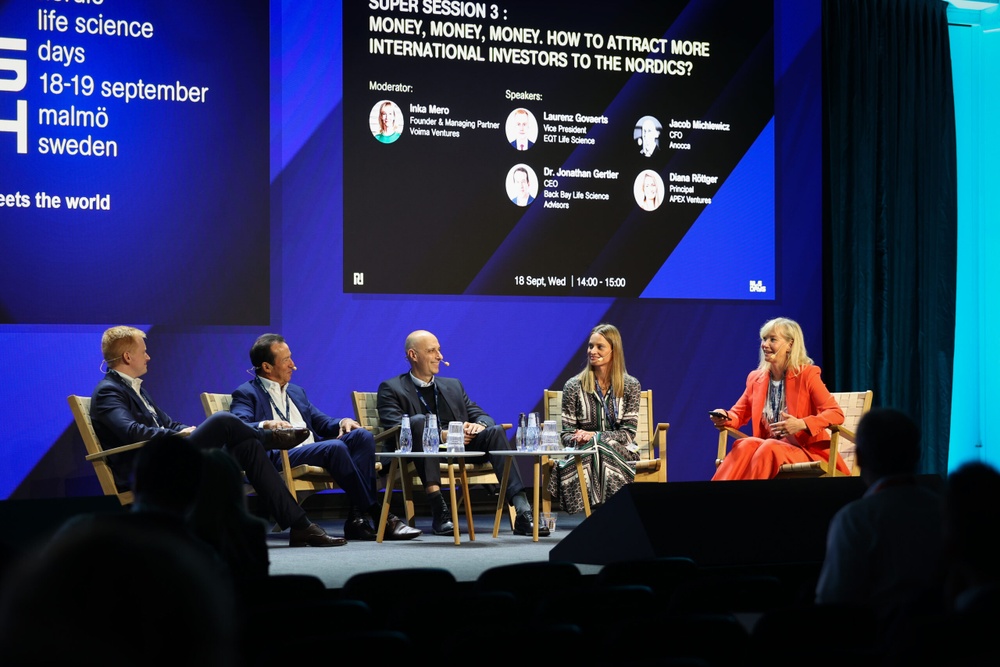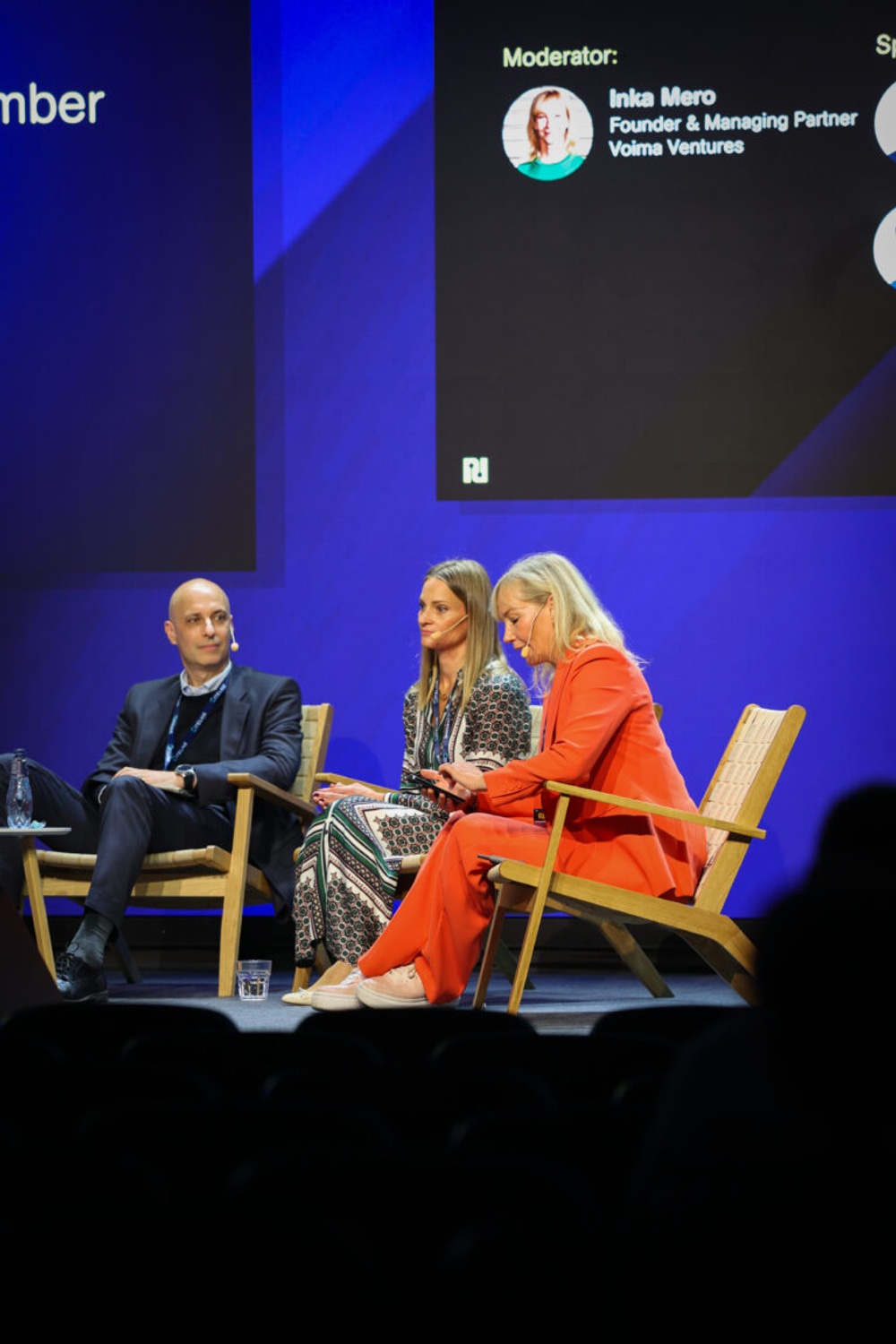Money, Money, Money: How to attract more investors to the Nordics
 NLSDays 2024 super session
NLSDays 2024 super sessionText: Daniel Gooch, Scius Communications
“All the things I could do, if I had a little money,” is a well-loved Abba song lyric very much taken to heart by Nordic life science, as a virtue of the sector is its capital-efficiency: companies here sure can do a lot for a little. You might brag about raising $100m in Boston to fund all the things you could do there, but in Sweden, Denmark, Norway, Iceland, and Finland, they’d likely only need $10m to achieve all that and still have a chunk of change left too.
NLSDays is where Nordic life science meets the world. The “Money, Money, Money’ super session panel, chaired by Inka Mero, Founder & Managing Partner of Voima Ventures, discussed in detail this ‘little money’ approach, and other life-lessons from Abba’s lyrics, as applied to attracting finance in the Nordics. In that region, biopharma investment has remained resilient, at around 2-3% of the global total. Sweden leads the field with 19 out of 28 disclosed Nordic financings. But Denmark tops the chart with Zealand Pharma’s DKK 7 bn (around USD 1 bn) placement being the third largest financing globally to date in 2024. This year represents a good recovery from the post-pandemic drop, with global biopharma financing being on track for over $100bn. Stockholm, Helsinki and Copenhagen are all becoming key players in the global start-up landscape, with VCs driving around 30% of total investment.
However, the share of US investors has dropped precipitously, much like the Nordic temperatures can do as the long winter nights approach. What to do, to get them (back) on board? Dr. Jonathan Gertler, CEO of Back Bay Life Science Advisor, provided several valuable insights from a US perspective. As he outlined, whilst there was a decade of upside, that’s fallen away, replaced with irrational behaviour and bad decisions, resulting in enormous headwinds due to investor reversal out of lifesciences in 2021. Whilst the first half of 2024 showed a tremendously good trend, in financings, that’s now stalled, partly due to geo-politics.
There’s also an emerging split between pharma/biotech where clinical trials results are mostly risky binary events, often resting on the efficacy of a single asset, where investors are holding back, compared to medtech and health tech which deal more with quality and patient systems, which are gaining more favour from investors. Whilst there is a byzantine US pricing system, the regulatory system is straight forward compared to Europe. And US investors want to know what the US launch and marketing plan is, right from the start, so ‘control the debate’ around that topic by having that locked in to your plans.
Setting out the financing perspective from a biotech, Jacob Michlewicz, CFO at Sweden’s Anocca, developing precision T cell immunotherapies, highlighted that starting a biotech and running into the clinic is an expensive sport, with finance always being on the table at board meetings. There are no shortcuts, you must keep on ploughing away. Besides equity financing, there are valuable sources of non-dilutive grants, and venture debt financing support from the European Investment Bank to consider. This all helps to advance the company towards the next value inflection.
“Who hasn’t heard a European biotech talk about wanting American money?”
Over at the deep-tech fund, APEX Ventures, where Diana Röttger is a Principal, they work with 16 companies covering a range of technologies, including space, quantum, and life sciences, with a focus on medical technologies that are solving a global problem. Fundamentally, the view from APEX Ventures is that they don’t believe the next big thing will come from one disciple, more from a convergence of disciplines, hence their wide interests. AI could bring a lot to the table, including in drug discovery, where the promise is the ability to understand biology better, create novel drugs, and bring them to market, faster. In pitches to the VC, Diana is keen to understand exactly what the tech benefit is, and how exactly the AI is helping, but sometimes the responses can be disappointing. ‘Software is dead, long live AI!’ say some, but sometimes software is not the key, hardware is, which is why they also invest there.
Picking up on some of the latest industry trends, Laurenz Govaerts, Vice President at EQT Life Science, highlighted the investor appetite for ADCs , novel obesity drugs, and now the great enthusiasm for radio-therapies. But the conversation is always on the next big thing, and how to differentiate the portfolio.
Back to the lyrics, “So I must leave, I’ll have to go, to Las Vegas or Monaco,’ and even way back in 1976, when this Abba hit came out, the Nordic aspiration to make it big in the US (and Europe beyond the Nordics) was front and centre. Who hasn’t heard a European biotech talk about wanting American money? But there’s an art to it, and it takes a lot of effort. So, how best to go about that?
Jonathan cut to the chase: it’s very difficult for an early-stage company not close to the ZIP code of a US investor, to attract them on board. But you can talk to them, and Key Opinion Leaders too, at events like NLSDays, and if they see later that you responded to their counsel, that can help when you have something new to say. Jacob concurred that it’s important to build investor relations over time and be out on the road early, as Anocca is doing as it heads towards European based clinical trials in 2025 and is currently looking to internationalise its investor base. For example, adding people with US backgrounds on to your SAB can help make the most of networks.
Laurenz added that a huge strength of Nordic companies is that they generally hit their KPIs. But a flip side is that there can be large cap tables with hundreds of small investors, which can be hard to manage. Plus the Nordics can be secluded from the international investment scene, and need, as investors, a mix of more specialized funds, to give maturity and help with the connections needed to make bridges to more international investors.
Is public funding good or bad? Or, as Abba puts it, “And win a fortune in a game, my life will never be the same.” Jonathan’s view was that to go public from a position of strength is a good flex. But when used, in desperation, to try and get any capital it’s a terrible double-edged sword, as you can end up a micro-cap in a down market, and not have the strength to be there. As Jacob advised, do not go too early! You need a clear roadmap to success, and attract quality, credible, investors that will support you, else the valuation starts to trickle down.
Finally, the panel were asked from the audience how the market might look in ten years. Jacob fielded that one, with the view that hopefully there would be more capital flowing in than today. This would help with the long-standing problem of, to use a baseball analogy, there’s enough seed financing to develop the junior league players, but not enough to enable them to step up to the major leagues. A decade from now, you’d want to see more Nordic biotech players there.
With a little more money, money, money it’s unbelievable what the Nordics could do, as there’s the talent, the ecosystem capital efficiency, and the potential to create cures for things we can’t even imagine.
About Nordic Life Science Days
NLSDays is the premier partnering event for the Nordic life science industry.
